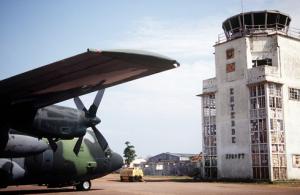Entebbe raid: 40 years onThe Entebbe rescue, 40 years later
On 4 July 1976 — 40 years ago Monday — Israeli commandos carried out a daring raid to rescue over 100 Jewish and Israeli hostages held by Palestinian and German terrorists at the Entebbe airport in Uganda. A week earlier, two terrorists from the Popular Front for the Liberation of Palestine (PFLP) and two German terrorists from the Baader-Meinhoff gang had hijacked Air France flight 139 as it took off from Athens bound for Paris, the final leg of its journey that had begun in Tel Aviv. When the plane landed in Uganda, the Jewish and Israeli passengers were separated from the others.

The old terminal building showing holes from raid // Source: wikipedia.org
On 4 July 1976 — 40 years ago Monday — Israeli commandos carried out a daring raid to rescue over 100 Jewish and Israeli hostages held by Palestinian and German terrorists at the Entebbe airport in Uganda.
A week earlier, two terrorists from the Popular Front for the Liberation of Palestine (PFLP) and two German terrorists from the Baader-Meinhoff gang had hijacked Air France flight 139 as it took off from Athens bound for Paris, the final leg of its journey that had begun in Tel Aviv. The hijackers demanded the release of several dozen of imprisoned terrorists and sympathizers in exchange for the hijacked hostages.
After a stop in Libya, where additional terrorists boarded the plane, the flight continued on to Uganda, then under the dictatorial rule of President Idi Amin Dada. Ugandan troops aided the hijackers in guarding the hostages.
When the plane landed in Uganda, the Jewish and Israeli passengers were separated from the others.
“Even now, as I am telling you the process by which the terrorists selected their hostages, it hurts me to say it,” recalled Avi Mor, a member of the IDF’s rescue mission who had escaped from the Nazis in Poland along with his family. “It was a similar selection process the Nazis administered when selecting who would go work and who would be sent to the gas chambers.”
According to another account, one of the hostages showed his tattoo to one of the German hijackers, who reportedly responded “I’m no Nazi! … I am an idealist.”
The hijackers extended the deadline for meeting their demands until 11:00 a.m. on 4 July.
With imperfect intelligence and minimal training, the IDF nevertheless received authorization to launch its rescue mission on 1 July. The mission’s main commander, Dan Shomron (later to become the IDF’s chief-of-staff), got final approval for the plan from Chief of Staff Mordechai Gur, Defense Minister Shimon Peres, and Prime Minister Yitzhak Rabin.
Two hundred elite IDF soldiers flew four American-made Hercules transport planes 2,000 miles under cover of night to rescue the 103 hostages. Despite the complexity of the mission, the IDF had two advantages. One was the element of surprise. The other was that the old terminal building, where the hostages were being held, was originally built by an Israeli firm, which shared blueprints with the IDF and allowed it to build a replica of the terminal to rehearse the rescue.
In the first plane was the rescue teams, led by Yoni Netanyahu, the older brother of current Prime Minister Benjamin Netanyahu. Also on the plane was a black Mercedes, a replica of the car used by Amin, in which the lead team would make its way to the terminal.
After the plane landed and the Mercedes emerged, the rescue team encountered a Ugandan guard. Though the operation’s second-in-command of Muki Betzer did not believe that the soldier posed a threat — Betzer had previously trained the Ugandan military — the commandos shot him with silenced guns.
The encounter with the Ugandan soldier forced the commandos to speed up the pace of their mission. The commandos made it to the hall and announced to the hostages to that had come to rescue them. On the way into building Yoni Netanyahu was fatally shot.
Within twenty minutes, the commandos had killed all eight terrorists and brought the surviving hostages back to the fourth transport plane to return to Israel. Three hostages, Pasco Cohen, Ida Borochovitch, and Jean-Jacques Mimouni died during the rescue. Another hostage, Dora Bloch, who was being treated in a Ugandan hospital after apparently choking on food, was taken from the hospital and shot on Amin’s orders in retaliation for the raid.
Prime Minister Netanyahu on Monday kicked off a four-nation tour of Africa in Uganda at the old terminal building to commemorate the 40th anniversary of the historic rescue.
This article is published courtesy of The Tower
